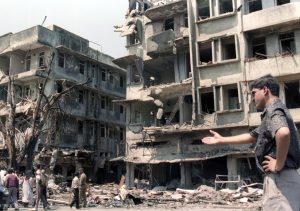1992 was an age of incoherence in India. A succession of weak, fractious, inept, and short-lived governments had pushed the country to the brink of bankruptcy and chaos. A fledgling Congress Party-led coalition under the leadership of Prime Minister P.V. Narasimha Rao was struggling to consolidate its position in Parliament and the administration, and to restore economic stability through a slew of reforms.
There were raging insurgencies in multiple theaters across India, the worst of these in Punjab, where a total of 3,883 people lost their lives in 1992 to a Sikh separatist movement before it was defeated, abruptly and comprehensively, the following year. In the northern state of Jammu and Kashmir, Islamist separatist terrorism backed by Pakistan resulted in 1,909 fatalities; multiple insurgencies in India’s Northeast saw 492 killed. Another 788 persons were killed in a widening Naxalite (left-wing extremist) rebellion along India’s eastern board, spanning large areas from Andhra Pradesh to Bihar. The combined toll of all such violence was 7,072 fatalities in 1992 (all data from the South Asia Terrorism Portal).
To the distant observer it might have seemed that much of India was aflame – and possibly ready for “balkanization.”
Outside Jammu and Kashmir, however, there was little evidence of Islamist terrorist mobilization, despite the strident polarizing campaigns of the Sangh Parivar, a complex network – both formal and informal – of political and social institutions linked to the Rashtriya Swayamsevak Sangh (which includes the present ruling Bharatiya Janata Party). The Sangh Parivar demonstrated across the country over the Babri Masjid, a 1529 mosque constructed over Hindu structures in Ayodhya believed by the devout to be the birthplace of the Hindu deity Ram. The dispute had lingered in court for over a century, with a case first filed in 1885. In 1949, when an idol of Lord Ram “mysteriously” appeared in the mosque, the then-Jawaharlal Nehru government locked the mosque, declaring the site a “contested area.”
In 1984, Hindutva groupings led by the Vishwa Hindu Parishad (VHP, the World Hindu Council) formed a committee to build a temple at the site of the Babri Masjid, with BJP leader Lal Krishna Advani chosen to head the campaign. But for the next two years, they floundered, finding little traction among the masses or at the ballot box. In the wake of Prime Minister Indira Gandhi’s assassination, the Congress Party won over 80 percent of the 514 seats in Parliament, with the Bharatiya Janata Party (BJP) reduced to just two at the 1984 elections.
Then, in 1986, a local court in Uttar Pradesh ordered that the locks be removed from the Masjid, and Hindus be allowed to worship there. The government, then headed by Jawaharlal Nehru’s grandson Rajiv Gandhi, chose not to appeal the decision. The locks were opened, perhaps in the misguided belief that this would help the ruling Congress Party consolidate the “Hindu vote bank.”
It was a colossal miscalculation.

































